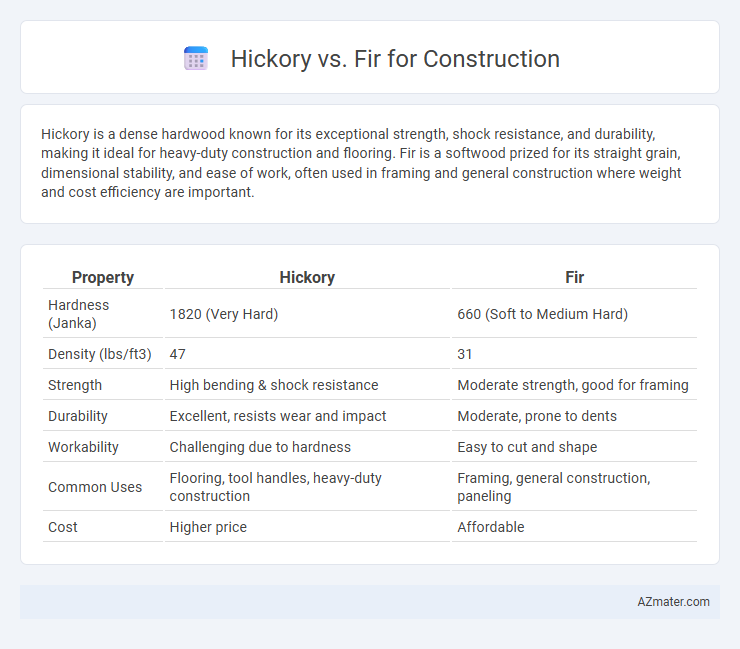Hickory is a dense hardwood known for its exceptional strength, shock resistance, and durability, making it ideal for heavy-duty construction and flooring. Fir is a softwood prized for its straight grain, dimensional stability, and ease of work, often used in framing and general construction where weight and cost efficiency are important.
Table of Comparison
| Property | Hickory | Fir |
|---|---|---|
| Hardness (Janka) | 1820 (Very Hard) | 660 (Soft to Medium Hard) |
| Density (lbs/ft3) | 47 | 31 |
| Strength | High bending & shock resistance | Moderate strength, good for framing |
| Durability | Excellent, resists wear and impact | Moderate, prone to dents |
| Workability | Challenging due to hardness | Easy to cut and shape |
| Common Uses | Flooring, tool handles, heavy-duty construction | Framing, general construction, paneling |
| Cost | Higher price | Affordable |
Introduction to Hickory and Fir in Construction
Hickory is renowned in construction for its exceptional hardness, density, and shock resistance, making it ideal for tool handles, flooring, and heavy-duty furniture. Fir, particularly Douglas fir, offers a strong, straight grain with excellent dimensional stability and workability, commonly used in framing, beams, and plywood. Both woods provide unique advantages; hickory excels in durability and impact resistance, while fir is preferred for structural applications due to its strength-to-weight ratio and ease of use.
Botanical and Physical Characteristics
Hickory wood, derived from the genus Carya, is renowned for its exceptional hardness, density, and shock resistance, making it highly durable in construction applications. In contrast, Fir, primarily from the genus Abies, offers a lighter, softer wood with moderate strength but superior dimensional stability and ease of machining. The dense grain structure of Hickory provides superior wear resistance, while Fir's straight grain and fine texture allow for smooth finishes, influencing their respective suitability in structural framing versus interior cabinetry or paneling.
Strength and Durability Comparison
Hickory offers superior strength and shock resistance compared to fir, making it ideal for heavy-duty construction projects requiring high load-bearing capacity. Fir is moderately durable with good dimensional stability but is less resistant to impact and wear than hickory. For long-lasting structural applications, hickory's density and hardness provide enhanced durability against physical stress and environmental factors.
Workability and Machinability
Hickory offers exceptional strength and shock resistance but presents moderate challenges in workability due to its density and hardness, requiring sharp tools for clean cuts. Fir, on the other hand, is easier to machine, exhibiting smooth cutting and shaping qualities that facilitate faster construction processes. The machinability of fir makes it favorable for projects requiring precision and speed, while hickory is preferred where durability and impact resistance are critical.
Weight and Density Differences
Hickory wood has a significantly higher density, typically around 47 to 56 lbs/ft3, compared to fir, which ranges from 28 to 34 lbs/ft3, making hickory much heavier and denser. This difference affects structural applications where weight is a critical factor, with fir preferred for frameworks requiring lighter materials. The greater density of hickory contributes to its superior hardness and durability but results in increased load on foundations and supports.
Resistance to Decay and Insects
Hickory wood exhibits moderate resistance to decay and insect damage, making it suitable for construction in environments with lower moisture exposure. Fir, specifically Douglas fir, offers better natural resistance to decay and insect infestation due to its dense grain structure and natural resin content, making it a preferred choice for exterior and structural applications. When prioritizing durability against environmental factors, fir generally outperforms hickory in long-term construction projects.
Cost and Availability
Hickory is generally more expensive and harder to source than fir due to its limited regional availability and slower growth rate, making it less common for large-scale construction projects. Fir offers a cost-effective alternative with widespread availability, especially Douglas fir, which is favored for its strength and consistent supply in North America. The price disparity reflects not only material costs but also the ease of procurement, with fir being highly accessible and suitable for budget-conscious construction needs.
Best Use Cases for Hickory
Hickory's exceptional hardness and shock resistance make it ideal for tool handles, flooring, and heavy-duty furniture where durability is crucial. Its dense grain provides superior wear resistance, outperforming fir in applications requiring impact strength and longevity. Hickory's moisture resistance also suits outdoor projects like fence posts and sports equipment, ensuring long-lasting performance under stress.
Best Use Cases for Fir
Fir wood is highly favored in construction for its strength-to-weight ratio, making it ideal for structural framing, beams, and trusses. Its consistent grain and resistance to warping provide stability in load-bearing applications and large-scale projects. Fir's excellent workability and ability to hold fasteners well also make it suitable for windows, doors, and general interior millwork.
Environmental and Sustainability Considerations
Hickory offers high durability and density, resulting in longer-lasting construction materials that reduce the need for frequent replacements, contributing to sustainability by preserving resources. Fir, particularly Douglas Fir, is widely harvested from sustainably managed forests certified by organizations like FSC, ensuring responsible forestry practices and carbon sequestration benefits. Both wood types have low embodied energy compared to synthetic materials, but fir's faster growth rate and regeneration make it a more renewable choice for eco-conscious construction projects.

Infographic: Hickory vs Fir for Construction
 azmater.com
azmater.com